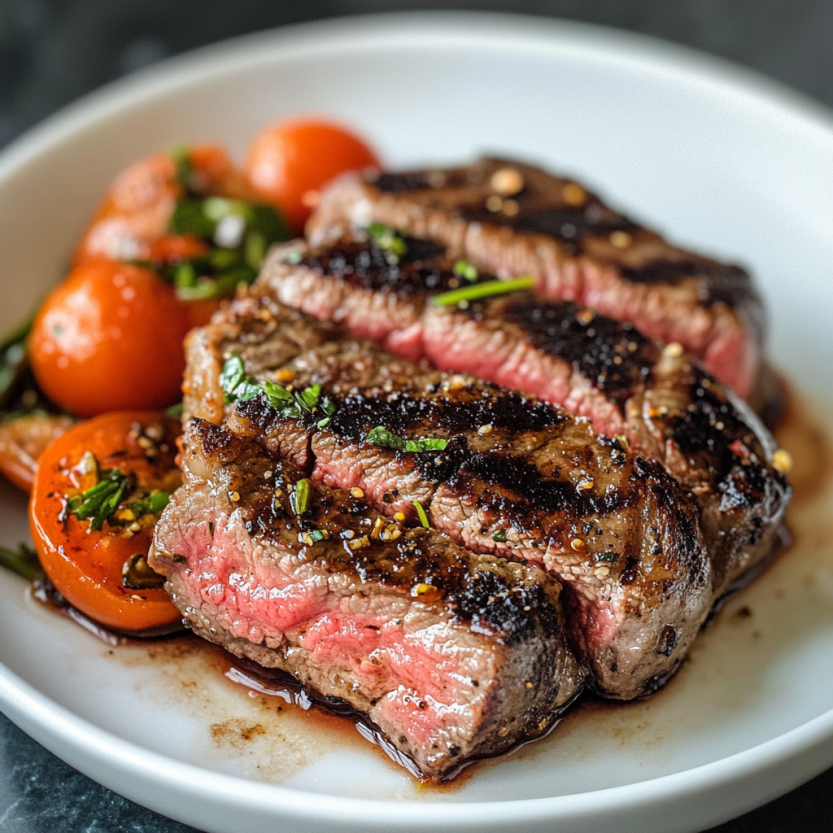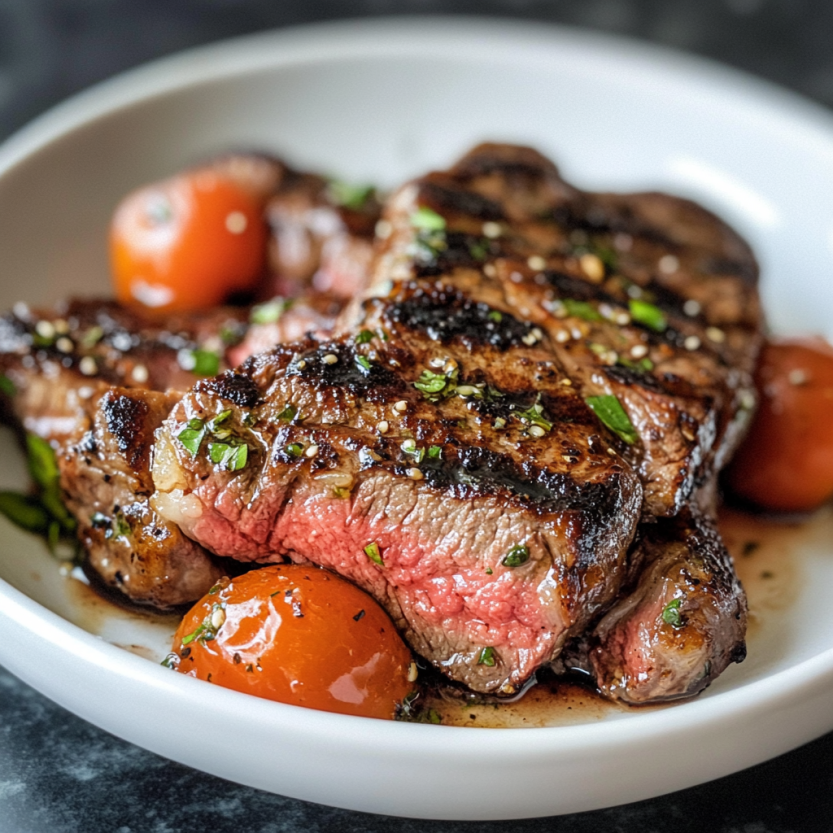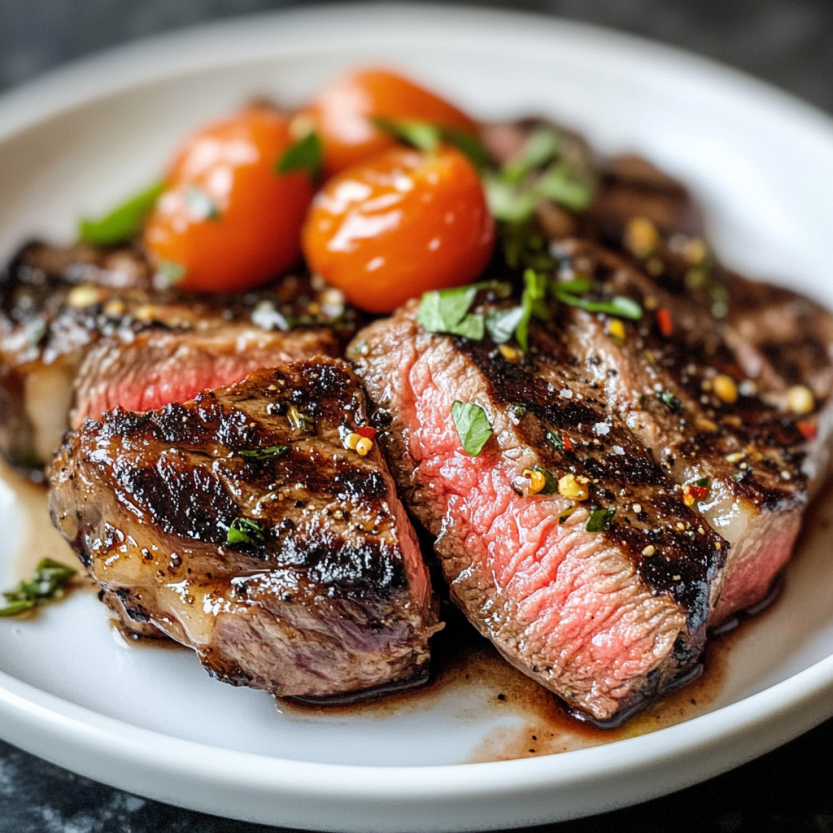 Save
Save
This tender and juicy ribeye steak delivers restaurant-quality results right in your own kitchen. The secret lies in creating that perfect seared crust while maintaining a buttery-soft interior, all enhanced with garlic-infused butter that elevates the natural flavors of this premium cut.
I first made this ribeye recipe when trying to recreate my favorite steakhouse experience during lockdown. After several attempts at perfecting the temperature and timing, my family now requests this "better than restaurant" steak for most celebrations.
Ingredients
- Ribeye steaks: 1-inch thick at room temperature for even cooking and maximum tenderness
- Salt and pepper: Generously applied to form that coveted crust and enhance the beef's natural flavor
- Olive oil: With its high smoke point creates the perfect searing foundation
- Butter: Adds richness and creates the basting liquid that infuses flavor throughout
- Fresh minced garlic: Provides aromatic depth that pairs perfectly with the richness of the beef
Step-by-Step Instructions
- Room Temperature Preparation:
- Allow steaks to sit out for 20-30 minutes before cooking. This crucial step ensures even cooking from edge to center and promotes better browning. Cold steaks directly from the refrigerator will cook unevenly with a gray band around the edges.
- Season and Prepare:
- Pat steaks completely dry with paper towels to remove surface moisture which interferes with proper searing. Apply salt and pepper generously on all sides including the edges. The seasoning forms the foundation of the crust and penetrates the meat during cooking.
- Preheat and Sear:
- Heat your cast iron or grill pan over medium-high heat until it begins to smoke slightly. Add oil and wait until it shimmers before carefully placing steaks in the pan. Allow the first side to sear undisturbed for a full minute before rotating 90 degrees to create those professional crosshatch marks.
- Butter Basting Magic:
- Add butter and minced garlic to the hot pan beside the steaks. As it melts, tilt the pan slightly and use a spoon to continuously bathe the steaks with the fragrant butter mixture. This process infuses flavor while contributing to even cooking and a beautiful crust.
- Flip and Finish:
- Turn steaks once and continue the basting process. Monitor the internal temperature with a meat thermometer inserted into the thickest part. The temperature will rise about 5 degrees during resting so remove steaks slightly before your target doneness.
- Rest Before Serving:
- Place steaks on a warm plate and tent loosely with foil for 5 minutes. This resting period allows juices to redistribute throughout the meat resulting in a more tender steak that retains moisture when cut.
 Save
Save
The butter basting technique is my absolute favorite part of this recipe. My grandfather was a chef who taught me that this method not only flavors the meat beautifully but also ensures even cooking. The aroma of garlic butter hitting the hot pan instantly transports me back to his kitchen where I first learned to appreciate properly cooked steak.
Selecting the Perfect Ribeye
Look for steaks with abundant marbling the white flecks of fat throughout the meat. This internal fat melts during cooking creating the juicy texture and rich flavor ribeyes are famous for. Thickness matters too aim for cuts at least 1-inch thick which allow proper searing without overcooking the center. For special occasions consider splurging on prime grade beef or dry-aged options which offer enhanced tenderness and concentrated flavor profiles.
Temperature Guide for Perfect Doneness
Achieving your ideal doneness level depends entirely on temperature precision. For rare with a cool red center remove steaks at 125°F which will rise to 130°F while resting. Medium-rare featuring a warm red center requires 130°F rising to 135°F. Medium with its pink center needs 135°F rising to 140°F. Medium-well showing just a hint of pink calls for 145°F rising to 150°F. Well-done with no pink requires 150°F rising to 155°F during rest. Remember that cooking beyond medium will reduce juiciness but the butter basting helps maintain moisture.
Serving Suggestions
Transform your perfectly cooked ribeye into a complete dining experience by considering thoughtful accompaniments. Creamy garlic mashed potatoes provide the ideal canvas for collecting excess steak juices and butter sauce. Roasted asparagus or brussels sprouts offer textural contrast and bright flavor to balance the richness of the meat. For a special touch consider making a quick red wine reduction with the pan drippings after removing the steaks simply add a splash of wine and reduce by half while scraping up the flavorful bits from the bottom of the pan.
 Save
Save
Recipe Questions
- → What's the secret to getting restaurant-quality ribeye at home?
The secret lies in a few key techniques: bringing steaks to room temperature before cooking, using a hot cast-iron skillet or grill pan, creating a good sear, and basting with garlic butter throughout cooking. The final crucial step is allowing steaks to rest 5 minutes under foil after cooking, which helps juices redistribute for maximum tenderness.
- → How do I know when my ribeye steak is cooked to my preferred doneness?
A digital meat thermometer is the most reliable method. Insert it into the center of the steak to check for these temperatures: 130-135°F for rare, 135°F for medium-rare, 140°F for medium, or 155°F for well-done. Remember the temperature will rise slightly during the resting period.
- → What sides pair best with this ribeye?
Creamy mashed potatoes and roasted vegetables create a classic steakhouse experience at home. The mashed potatoes soak up the delicious garlic butter sauce, while roasted vegetables provide color, nutrition, and textural contrast to the tender meat.
- → What's the best way to reheat leftover steak without drying it out?
Avoid the microwave, which can toughen meat. Instead, warm leftover steak gently in a cast-iron skillet over low heat or bake it in a 250°F oven until just heated through. This gentle reheating helps maintain the steak's moisture and tenderness.
- → Why is it important to let steaks come to room temperature before cooking?
Bringing steaks to room temperature for 20-30 minutes before cooking allows for more even heat distribution. Cold steaks placed on heat tend to cook unevenly, with exteriors potentially overcooking before the center reaches desired temperature. Room-temperature steaks cook more uniformly from edge to center.
- → What's the purpose of basting the steak with butter?
Butter basting serves multiple purposes: it adds rich flavor, helps conduct heat for more even cooking, creates a beautiful browned exterior, and infuses the meat with the aromatic compounds from the garlic. The technique elevates a simple steak to restaurant quality by adding depth and complexity to the flavor profile.